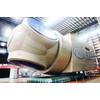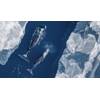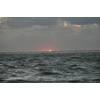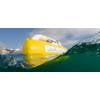Study: Electrical Properties of Topological Insulators

The NRL research team, left to right: Dr. Berend Jonker, Dr. Jeremy Robinson, Dr. Connie Li, and Dr. Olaf van't Erve. (Image: U.S. Naval Research Laboratory)
By Donna McKinney
Scientists at the U.S. Naval Research Laboratory (NRL) have demonstrated for the first time that one can electrically access the remarkable properties predicted for a topological insulator (TI). They used a ferromagnetic metal/tunnel barrier contact as a voltage probe to detect the spin polarization created in the topologically protected surface states when an unpolarized bias current is applied. This accomplishment identifies a successful electrical approach that provides direct access to the TI surface state spin system, significantly advances our fundamental understanding of this new quantum state, and enables utilization of the remarkable properties these materials offer for future technological applications. The results of this research have been published in Nature Nanotechnology (see http://www.nature.com/nnano/index.html and the digital object identifier 10.1038/nnano.2014.16).
Topological insulators constitute a new quantum phase of matter distinct from the classic dichotomy of simple metals and semiconductors. This phase was predicted in 2007 to exist in certain materials with high spin-orbit interaction, and confirmed a year later by spectroscopic measurements. While the bulk of a TI material is nominally an insulator, the surface layer (approximately one nanometer thick) is occupied by metallic states that are topologically protected from perturbations to their environment. TIs are expected to exhibit new behaviors and open horizons for science previously inaccessible with "conventional" materials. One of the most striking properties is that of spin-momentum locking—the spin of an electron in the TI surface state is locked at a right angle to its momentum. This consequently implies that when an unpolarized charge current flows in the topologically protected surface states, a net electron spin polarization should spontaneously appear whose amplitude and orientation are controlled by the charge current. This remarkable property has been anticipated by theory since 2010, but never measured by a transport experiment. Detecting this spin polarization directly as a voltage is key to understanding the fundamental properties of such materials, and interfacing them to electronic circuitry for future device applications.
The NRL team showed that a bias current indeed creates a net surface state spin polarization via spin-momentum locking in thin Bi2Se3 epitaxial films, and that this polarization was directly manifested as a voltage on a ferromagnetic metal contact. This voltage is proportional to the projection of the TI spin polarization onto the contact magnetization, is determined by the direction and magnitude of the bias current, and its sign is that expected from spin-momentum locking rather than a Rashba effect. Similar data are obtained for two different ferromagnetic tunnel barrier structures, Fe/Al2O3 and Co/MgO/graphene, demonstrating that these behaviors are independent of the details of the ferromagnetic contact.
This accomplishment offers a unique mechanism to generate and control spin in topological insulators, and may be useful for information processing. The International Technology Roadmap for Semiconductors, for example, has identified spin as a viable alternate state variable that should be developed for use in advanced electronic systems to complement the functionality provided by charge. The potential applications would certainly be long-term, because so little is known at this point, explains NRL's Dr. Berry Jonker. The existence of this new quantum phase of matter was just confirmed in 2008 and its properties yet to be fully understood, so it is a bit difficult to speculate on applications. But potential application areas include reconfigurable electronics, spintronics and quantum information processing.
The research team consists of Drs. Connie Li, Olaf van 't Erve, and Berend Jonker from NRL's Materials Science and Technology Division; Dr. Jeremy Robinson from NRL's Electronics Science and Technology Division; and Dr. Ying Liu and Prof. Lian Li from the University of Wisconsin, Milwaukee.
nrl.navy.mil













 February 2025
February 2025



